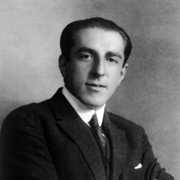Julio Rey Pastor
| Julio Rey Pastor | |
|---|---|
 | |
| Born |
14 August 1888 Logroño, Spain |
| Died |
21 February 1962 (aged 73) Buenos Aires, Argentina |
| Nationality |
|
| Fields | Mathematics |
| Institutions |
Complutense University of Madrid University of Buenos Aires |
| Alma mater | Complutense University of Madrid |
| Doctoral advisor |
Eduardo Torroja Caballé Felix Klein |
| Doctoral students |
Alberto Gonzalez Dominguez José Orts Aracil Sixto Ríos Ricardo San Juan Llosá |
Julio Rey Pastor (14 August 1888 – 21 February 1962) was a Spanish mathematician and historian of science.
Julio Rey Pastor studied high school in his hometown, and began his studies in Sciences in Vitoria. He moved to the University of Saragossa, where he found a stimulating environment in mathematics. Zoel García de Galdeano, Professor of Analytical Geometry and Calculus, was the professor who most influenced Rey Pastor’s scientific work. He graduated with honors in 1908. Rey Pastor earned his doctorate from Complutense University of Madrid in 1909, under supervision of Eduardo Torroja Caballé. Between 1911 and 1914, he studied at the University of Berlin and the University of Göttingen, under the supervision of Felix Klein. During that period, he also studied under the supervision of Professors Hermann Schwarz, Friedrich Hermann Schottky (father of Walter Schottky, Nobel Prize in Physics in 1911), and Ferdinand Georg Frobenius.[1]
His report sent to the JAE allows us to assess the significance of his studies in Germany. He especially liked Schwarz’s lectures on analytic functions and synthetic geometry, not only because of their innovations but also because Schwarz’s teaching method. In this report, Rey proposed the creation of a "seminar in mathematics to arouse the research spirit of our school children.” His proposal was accepted and in 1915 the JAE created the Mathematics Laboratory and Seminar, an important institution for the development of research on this field in Spain.
Undoubtedly, the creation of the laboratory was a result of Rey Pastor’s studies in Germany, and it was intended to overcome the isolation and individualism of the Spanish mathematicians. This laboratory, under the National Institute of Sciences, was first installed in the basement of the National Library, then moved to a modest apartment on Santa Teresa St., then to the building of the Center for Historical Studies and, finally, became part of the Consejo Superior de Investigaciones Científicas (CSIC), renamed Instituto Jorge Juan de Matemáticas in 1939.
Rey Pastor’s scientific work focused both on research, and textbooks and articles for the general public. They reflected the changes that were taking place in mathematics. He was also interested in the history of science and, specifically, mathematics in Spain.
In 1917, Rey Pastor first traveled to Argentina, invited by the Institución Cultural Española. This visit marked not only his life and professional career, but also had a decisive influence on mathematical studies in Argentina. From then until General Perón's rise to power in 1946, Rey Pastor lived in Spain and Argentina, fulfilling his academic duties thanks to the different seasons in the two hemispheres.
In 1951, he was appointed director of the Instituto Jorge Juan de Matemáticas in the CSIC. His plans in Spain included two projects: the creation, within the CSIC, of an Institute of Applied Mathematics, and the foundation of a Seminar on the History of Science at the university.
In 1954, he entered the Royal Spanish Academy, proposed by Gregorio Marañón, and Francisco Javier Sánchez Cantón, and delivered an acceptance speech on the algebra of language. (He had become a member of the Academy of Sciences in Madrid in 1920, and of the Academy of Sciences in Buenos Aires in 1932).
Rey Pastor showed his passion for mathematics as a researcher, as promoter of new studies, and as creator of agencies and institutions that enhanced the development of mathematics in Spain. A curious recognition, among many others, came in the last years of his life. In 1953, The British Astronomical Society gave his name to a crater on the moon between those named after Frederic Cuvier and Michael Faraday.
In 1956, he went back to Argentina and only returned to Spain on the occasion of the entry of his disciple, Sixto Ríos into the Academy of Sciences, on June 21, 1961. In his speech, Rey Pastor recalled the process of creation of the laboratory and the support from the JAE.
Rey Pastor occupied a seat in the Real Academia Española between 1953 and 1962. He was honored with a Spanish stamp in 2000.
See also
- António Aniceto Monteiro
References
- ↑ Link to the Spanish Council of Scientific Research (CSIC): http://www.residencia.csic.es/jae/en/protagonistas/41_c.htm
Further reading
- Gasca, Ana Millán (1988). El matemático Julio Rey Pastor. Logroño: Colegio Universidad de la Rioja. ISBN 84-600-5432-2.
External links
|